UK economy: Where companies grow and export
- Published
Some of the country's most deprived areas could provide the potential for the best quality business growth according to research commissioned by BBC English Regions.
As the country continues to face economic challenges the research, conducted by information analysts Experian, looked at evidence for growth, or otherwise, from 2010 to 2012 in every local authority area in England.
It suggests that there are high proportions of 'champion' businesses - companies with the ingredients to prosper - in some of the least resilient areas of England such as the North East and Yorkshire and Humber.
-
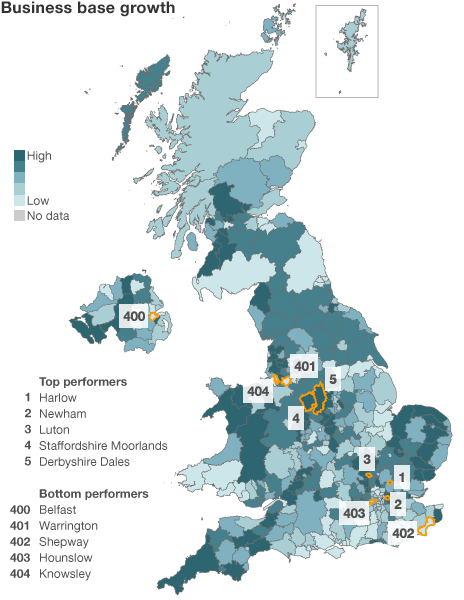 This map ranks each local authority district in the UK based upon average annual growth in its business base between 2010 and 2012.
This map ranks each local authority district in the UK based upon average annual growth in its business base between 2010 and 2012.
It provides an indication of the health of a local area as it takes into account start ups and insolvencies.
Growth has been witnessed in around two thirds of local authorities right across the UK, with top performers Harlow and Newham in the South East. -
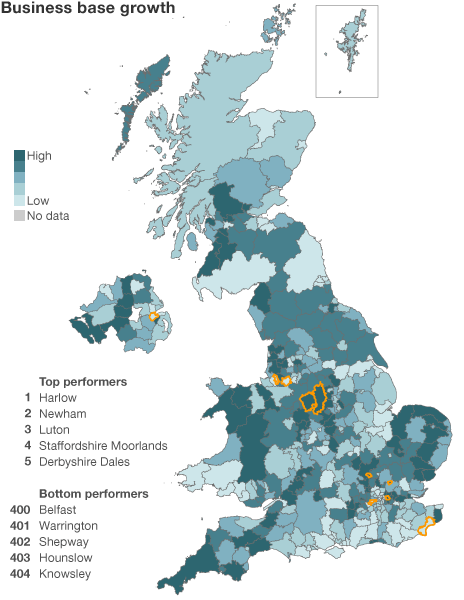 This map ranks each local authority district in the UK based upon average annual growth in its business base between 2010 and 2012.
This map ranks each local authority district in the UK based upon average annual growth in its business base between 2010 and 2012.
It provides an indication of the health of a local area as it takes into account start ups and insolvencies.
Growth has been witnessed in around two thirds of local authorities right across the UK, with top performers Harlow and Newham in the South East. -
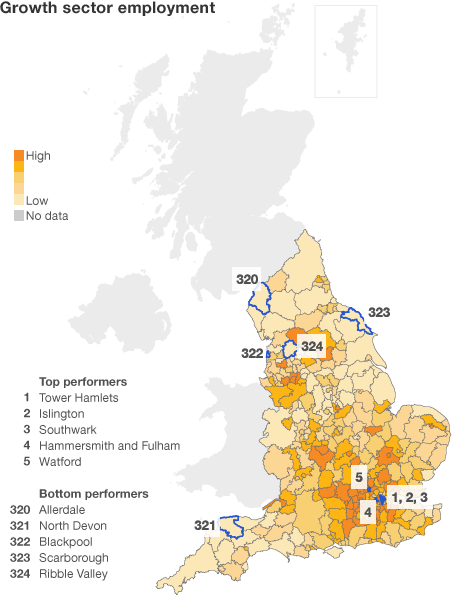 This map ranks each local authority district in England based upon the proportion of employment it has in sectors with growth potential - which include finance, insurance and pensions, real estate, professional services, computing and information services.
This map ranks each local authority district in England based upon the proportion of employment it has in sectors with growth potential - which include finance, insurance and pensions, real estate, professional services, computing and information services.
Given the location of these industries, we anticipate that sector led growth will largely come from the South East and London. -
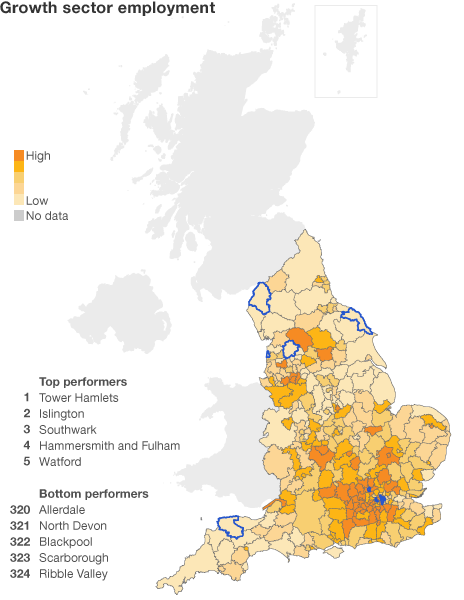 This map ranks each local authority district in England based upon the proportion of employment it has in sectors with growth potential - which include finance, insurance and pensions, real estate, professional services, computing and information services.
This map ranks each local authority district in England based upon the proportion of employment it has in sectors with growth potential - which include finance, insurance and pensions, real estate, professional services, computing and information services.
Given the location of these industries, we anticipate that sector led growth will largely come from the South East and London. -
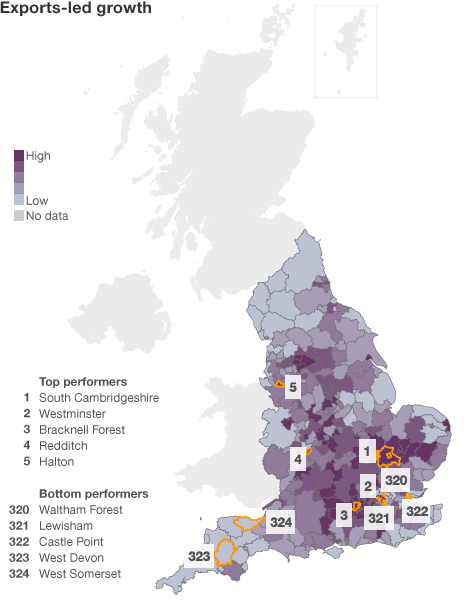 This map ranks each local authority district in England based upon their exports.The South East and London have the highest proportion of exporting businesses, supported by the strong transport networks within
and surrounding the capital, including key international airports.
This map ranks each local authority district in England based upon their exports.The South East and London have the highest proportion of exporting businesses, supported by the strong transport networks within
and surrounding the capital, including key international airports.
But research suggests there are opportunities right across England for businesses to boost their exports and support the rebalancing of the UK. -
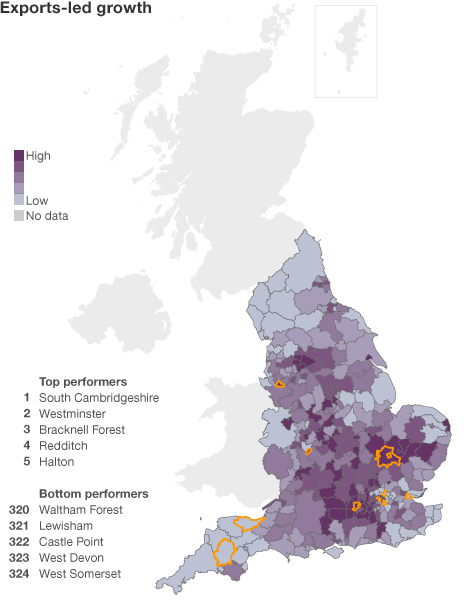 This map ranks each local authority district in England based upon their exports.The South East and London have the highest proportion of exporting businesses, supported by the strong transport networks within
and surrounding the capital, including key international airports.
This map ranks each local authority district in England based upon their exports.The South East and London have the highest proportion of exporting businesses, supported by the strong transport networks within
and surrounding the capital, including key international airports.
But research suggests there are opportunities right across England for businesses to boost their exports and support the rebalancing of the UK.
Growth
Despite the challenging economic conditions, in just over 70% of local authority districts (LADs), the absolute number of businesses increased between 2010 and 2012.
Growth in the business base provides a good indication of the health of a local area, as it takes into account both insolvencies and business start-ups.
Absolute growth in the business base was witnessed right across England, but particularly in the East of England, in places such as Harlow and Luton.
In Harlow, the numbers of businesses grew year on year between 2010 and 2012 from 3,782 companies in 2010 to 4,260 in 2012 - an average annual increase of 6.2%.
In Luton the average growth in businesses was 4.2% from 9,354 to 10,139.
Particularly strong growth was also witnessed in the South West - Gloucester grew on average by 3% per year during this period.
In terms of absolute numbers Leeds had the largest increase in number of companies trading, up 1,464 businesses.
The borough of Westminster lost the most number of businesses from its base, with 11,076 companies moving, closing down or going insolvent.
The research looked at the growth of the business base across the UK from 2010 to 2012. It found that Knowsley in Merseyside performed the worst - its average annual growth of the business base from 2010 to 2012 was -21.4%, a fall in the number of companies in the area from 6,610 to 4,070.
Belfast was fifth worst for business base growth in the UK, averaging a decline of -9.1% over 2010 to 2012 from 18,119 to 14,950 companies.
Newtownabbey and North Down in Belfast were also in the top ten worst performing areas with neither of them showing any positive growth in the business base since 2010.
Northern Ireland saw no positive growth in the business base last year.
In Scotland, the best performing area is Stirling with an increase in the business base from 5,273 companies in 2010 to 5,507 in 2012 and increase of 2.2% a year on average.
Edinburgh saw an average decline in its business base from 32,437 in 2010 to 30,049 a fall of 3.7%.
In Scotland the business base has grown on average by 0.1%, compared to England's growth of 0.5%.
In Northern Ireland growth averaged -3.3%. Wales also suffered negative growth, with the business base shrinking 0.3% between 2010 and 2012.
The best performing area in Wales was Conwy, expanding its business base by an average of 1.8% from 2010 to 2012 from 5,971 companies to 6,191.
In Bridgend the business base shrank by 4.8%between 2010 and 2012 to 6,055 companies.
Business Champions
The report also looked at the quality of companies in areas, and found that in some of the most deprived districts strong performers emerged.
Experian scored companies against a set of criteria which included the firms youth, size and relative growth, directors that show entrepreneurial skill, appetite for business risk and real international outlook.
The North East followed by Yorkshire and the Humber have the highest proportion of "champion" businesses
Middlesbrough, one of the most deprived local authorities in England, is one of the top 5 areas with a higher than average proportion of business champions
In Newcastle upon Tyne around a third of the workforce is employed in the public sector, yet it ranks within the top 10 local authority areas for its proportion of business champions
All but two of Yorkshire and the Humber's local authorities are ranked within the top 50% of local authority areas for their proportion of business champions. Within Calderdale and Ryedale around 13% of businesses are classed as high growth businesses.
Export growth
Although businesses that export only make up only a small proportion of the UK economy they have a wide reach. In 2011 UK exports were around £300bn.
London and the South East have the highest proportion of exporting businesses, followed by the East of England and the West Midlands.
Within London top exporting LADs include Westminster, Camden, Kensington and Chelsea and Hammersmith and Fulham, all of which have above average proportion of foreign business owners with a higher tendency to export.
In the South East - top exporting LADs are located along the M4 corridor: Bracknell Forest, Slough, Runneymede - a major hub for high tech companies, many of whom will export given their innovative nature and foreign ownership. Crawley is also a high performer and is in close proximity to Gatwick Airport.
South Cambridgeshire in the East of England has the highest overall proportion of businesses that export - these businesses make up 2.8% of the business base; well above the England average of 0.6%.
South Cambridge has a high proportion of high tech firms that are export oriented and a varied sector mix.
Experian believes export potential in the future is likely to continue growing in these areas.
Sector growth
The sectors that Experian anticipates will grow over the short and medium term are largely within the financial insurance and business service sectors.
They include media activities, computing and information services, finance, insurance and pensions and real estate.
Given the location of these industries, Experian anticipate that sector led growth will come from South East, London and the surrounding areas.
The North West also performs relatively highly given its growing service sector in financial and insurance services particularly in Manchester.
- Published19 March 2012